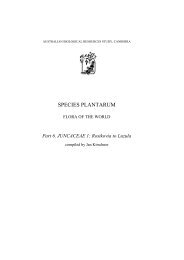Part 7. JUNCACEAE 2: Juncus - Species Plantarum Programme
Part 7. JUNCACEAE 2: Juncus - Species Plantarum Programme
Part 7. JUNCACEAE 2: Juncus - Species Plantarum Programme
You also want an ePaper? Increase the reach of your titles
YUMPU automatically turns print PDFs into web optimized ePapers that Google loves.
42<br />
SPECIES PLANTARUM — FLORA OF THE WORLD (2002)<br />
Perennials, c. 15–55 cm tall, loosely caespitose; rhizome long, creeping, usually with long<br />
internodes; stolons present. Stem slightly compressed, papillose. Cataphylls absent or 1–2,<br />
dull brownish, to c. 3 cm long; basal leaves few. Cauline leaves 1–3; lower leaves c. 10–25 cm<br />
long; upper leaves with blade 4–7 cm long, c. 1.5–2.5 (–4.0) mm wide; sheaths narrow, with<br />
a very narrow membranous margin; auricles ±absent or linear, subacute, to 0.5–0.7 mm long;<br />
apex subulate. Lower bract reduced, c. 0.5–2.0 cm long, ±shorter than inflorescence; middle<br />
bracts lanceolate, acuminate, to c. 6 mm long, scarious. Inflorescence a single sessile head<br />
(rarely up to 3–4 heads), globose, rarely hemispherical, 8–15 (–30)-flowered, with other<br />
heads on peduncles to c. 5 cm long. Tepals ±equal, c. 4.5–5.3 (–5.7) mm long, usually<br />
abaxially scabrid; outer tepals sometimes slightly longer, lanceolate, acute or subacute,<br />
bright castaneous, with central band green or later stramineous; inner tepals ovate-lanceolate,<br />
obtuse, broadly bordered, with margins membranous. Stamens 6; anthers 0.9–1.5 mm long;<br />
filaments 0.7–1.2 mm long; style c. 1.0–1.4 mm long; stigmas 1.5–2.5 mm long. Capsule<br />
±ovoid, trilocular, trigonous, ±truncate with a short mucro, ±equalling perianth, c. 3.5–4.5 mm<br />
long. Seeds narrowly ellipsoid, ±pale brown, c. 0.6–0.7 × c. 0.2 mm long, or 1.4–1.8 mm long<br />
including two appendages each 0.5–0.6 mm long, ±smooth; outer seed-coat ±loose. Fig. 52.<br />
Pacific North America from British Columbia and Alberta in SW Canada to California.<br />
71: ABT, BRC. 73: IDA, MNT, ORE, WAS, WYO. 76: CAL, NEV, UTA. Wet meadows,<br />
boggy slopes, seepage areas, in the mountains above 1000 m. Map 198.<br />
73. IDAHO: Valley Co., SW of Warm Lake, W.H.Baker 11851 (W). OREGON: Baker Co., Blue Mtns,<br />
Elkhorn Ridge, 5 km N of Anthony Lake, B.Maguire & A.H.Holmgren 26936 (W). WASHINGTON: Mt<br />
Paddo, 1 Aug 1908, W.Suksdorf [A.Kneucker, Cyper. Junc. Exs.] 269 (W); Mt Adams, Aug 1882, Henderson<br />
1527 (W). 76. UTAH: Alta, Wahsatch Mtns, 6 Aug 1879, M.E.Jones 1199 (para: W)<br />
21. <strong>Juncus</strong> howellii F.J.Herm., Leafl. W. Bot. 5: 182 (1949)<br />
T: USA, California, Trinity Co., N of Carrville, summit of Scotts Mtns, 24 Aug 1936, J.T.Howell 12750; holo:<br />
USNA; iso: CAS.<br />
Illustration: C.L.Hitchcock & al., Vasc. Pl. Pacif. Northw. 1: 200 (1969).<br />
Map: R.E.Brooks & C.E.Clemants, Fl. N. Amer. 22: 227 (2000).<br />
Perennials, 20–30 cm tall, loosely caespitose; rhizome creeping, long; stems slightly<br />
compressed, loosely tufted or spaced. Cataphylls 0–2, loose, brownish, to c. 7 cm long; basal<br />
leaves 2–4. Cauline leaves 2–3, flat, 12–15 (–30) cm long, 2–4 mm wide; sheaths ±loose;<br />
margins membranous; auricles scarious, oblong, obtuse, 1–2 (–3) mm long. Lower bract<br />
reduced, to c. 3 cm long, much shorter than inflorescence; margins papillose-serrulate.<br />
Inflorescence decompound, anthelate, loose, c. 4–9 cm long, of (2–) 3–9 hemispherical<br />
3–8 (–10)-flowered heads c. 10–15 mm wide. Tepals subequal; outer tepals usually slightly<br />
shorter, ovate-lanceolate, 5.2–6.4 mm long, with central band pale green bordered deep<br />
castaneous and distally scabrid; apex acuminate, dark; margins membranous to brownishscarious,<br />
broad, subabruptly narrowing (apex obtuse or mucronate), sometimes forming very<br />
short auricles. Stamens 6; anthers 1.8–2.6 mm long; filaments 0.5–1.0 mm long; style c. 0.6 mm<br />
long. Capsule trilocular, obovoid; apex subobtuse, subabruptly narrowing in a short mucro,<br />
c. 3.5–4.8 mm long, shorter than perianth, tan. Seeds ±ellipsoid, 0.5–0.7 × c. 0.25 mm long,<br />
conspicuously reticulate, brown; appendages distinct, 0.2–0.4 mm long each. Fig. 53.<br />
Endemic in the mountains of California, Oregon and Washington; an occurrence in Idaho<br />
requires confirmation but is possible. 73: ?IDA, ORE, WAS. 76: CAL. Moist meadows and<br />
open damp places in the mountains. Map 199.<br />
76. CALIFORNIA: Plumas Co., Butterfly Valley, W of Keddie, L.S.Rose 66068 (AAU); Siskiyou Co., Bear<br />
Springs area, c. 1600 m, W.J.Ferlatte 2109 (UC); Siskiyou Co., Parks Ck Road, c. 1.5 km N of Trinity Co.<br />
border, c. 2100 m, 23 Jul 1986, W.J.Ferlatte (UC); Lassen National Park, Hat Ck, c. 2100 m, H.Bailey &<br />
V.Bailey 2908 (UC).<br />
22. <strong>Juncus</strong> repens Michx., Fl. Bor.-Amer. 1: 191 (1803)<br />
Cephaloxys flabellata Desv., J. Bot. (Desvaux) 1: 324 (1809), nom. illeg. T: USA, Carolina, Georgia,<br />
A.Michaux; lecto: P, fide H.Balslev, Fl. Neotrop Monogr. 68: 104 (1996); iso: MO, P, W [two specimens from<br />
Carolina, L.A.G.Bosc].












